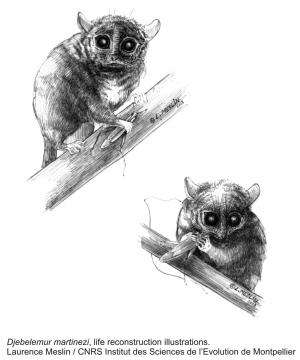Djebelemur martinezi, artist's reconstructions based on life-history traits inferred from the study of new fossil remains. Credit: CNRS
Fossils discovered in Tunisia challenge several hypotheses concerning the origin of toothcombed primates (Malagasy lemurs, Afro-Asian lorises and African galagos). The fossils are of a small primate called Djebelemur, which lived around 50 million years ago. They were discovered by a French-Tunisian team from the Institut des Sciences de l'Evolution in Montpellier (CNRS/Université Montpellier 2/IRD) and the Office National des Mines (ONM) in Tunis. According to the paleontologists, Djebelemur was probably a transitional form leading to the appearance of tooth-combed primates. However, according to genetic data, these primates appeared at least 15 million years earlier. Djebelemur therefore challenges the hypotheses put forward by molecular biology. The work, which has just been published in Plos One, makes it possible to reconstruct a chapter in the evolutionary history of this lineage. In addition, it may help to refine genetic models.
Tooth-combed primates, also called strepsirrhines, comprise lemurs and lorisiforms (small primates which include lorises and galagos). In these primates, the anterior teeth of the lower jaw take the form of a comb. This is mainly used for grooming, but also, in some species, for procuring the natural gums that make up part of their diet.
A key question debated by primatologists concerns the time when strepsirrhine primates first appeared. Recent genetic data dates the origin of lemurs and lorises to the onset of the Tertiary period, just after the disappearance of the dinosaurs (approximately 65 million years ago). Some molecular biologists even believe that divergence of the two groups occurred 80 million years ago. However, paleontological data does not corroborate these hypotheses: the oldest known lorisiform fossil dates from a mere 37 million years ago. Could this simply be due to a gap in the fossil record? The fossils discovered by the Institut des Sciences de l'Evolution in Montpellier (CNRS/Université Montpellier 2/IRD) and the ONM in Tunis suggest otherwise: it is the genetic models that may need to be revised.
Discovered in the sediments of a former lake in Djebel Chambi National Park, Tunisia, the approximately 50 million-year-old fossils belong to a small primate called Djebelemur (lemur of the Djebel). This was a tiny animal weighing scarcely 70 g. It was most certainly nocturnal, a predator of insects and a tree-dweller. Some of its morphological characteristics suggest that it was a distant relative of lemurs, galagos and lorises. However, although it did not yet have such a specialized toothcomb, it exhibited a tooth structure that had already been transformed, an early stage of the anterior dentition of today's strepsirrhines.
Djebelemur thus appears to be a transitional form, pre-dating the lorisiform-lemuriform divergence. Therefore, tooth-combed primates probably did not originate as early as molecular biologists have claimed. This is likely to have occurred less than 50 million years ago, the age of the Djebelemur fossil.
This is not the first time that genetic data disagrees with paleontological data. For many groups of mammals, geneticists tend to put forward earlier dates of origin than those provided by direct observation of the fossil record. Molecular biology increasingly seeks to refine its models by constraining them with fossil data. In the case of the origin of tooth-combed primates, Djebelemur could prove to be a significant milestone making it possible to reset the molecular clock and improve estimates of divergence dates derived from molecular phylogenies.
More information: "Djebelemur, a Tiny Pre-tooth-combed Primate from the Eocene of Tunisia: a Glimpse into the Origin of Crown Strepsirhines." Laurent Marivaux, Anusha Ramdarshan, El Mabrouk Essid, Wissem Marzougui, Hayet Khayati Ammar, Renaud Lebrun, Bernard Marandat, Gilles Merzeraud, Rodolphe Tabuce, Monique Vianey-Liaud Published in Plos One, 4 December 2013.
Journal information: PLoS ONE
Provided by CNRS





















